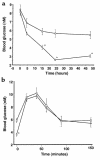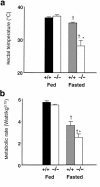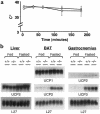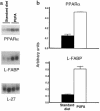Peroxisome proliferator-activated receptor alpha mediates the adaptive response to fasting
- PMID: 10359558
- PMCID: PMC408372
- DOI: 10.1172/JCI6223
Peroxisome proliferator-activated receptor alpha mediates the adaptive response to fasting
Abstract
Prolonged deprivation of food induces dramatic changes in mammalian metabolism, including the release of large amounts of fatty acids from the adipose tissue, followed by their oxidation in the liver. The nuclear receptor known as peroxisome proliferator-activated receptor alpha (PPARalpha) was found to play a role in regulating mitochondrial and peroxisomal fatty acid oxidation, suggesting that PPARalpha may be involved in the transcriptional response to fasting. To investigate this possibility, PPARalpha-null mice were subjected to a high fat diet or to fasting, and their responses were compared with those of wild-type mice. PPARalpha-null mice chronically fed a high fat diet showed a massive accumulation of lipid in their livers. A similar phenotype was noted in PPARalpha-null mice fasted for 24 hours, who also displayed severe hypoglycemia, hypoketonemia, hypothermia, and elevated plasma free fatty acid levels, indicating a dramatic inhibition of fatty acid uptake and oxidation. It is shown that to accommodate the increased requirement for hepatic fatty acid oxidation, PPARalpha mRNA is induced during fasting in wild-type mice. The data indicate that PPARalpha plays a pivotal role in the management of energy stores during fasting. By modulating gene expression, PPARalpha stimulates hepatic fatty acid oxidation to supply substrates that can be metabolized by other tissues.
Figures








Similar articles
-
Altered constitutive expression of fatty acid-metabolizing enzymes in mice lacking the peroxisome proliferator-activated receptor alpha (PPARalpha).J Biol Chem. 1998 Mar 6;273(10):5678-84. doi: 10.1074/jbc.273.10.5678. J Biol Chem. 1998. PMID: 9488698
-
Liver fatty acid binding protein is required for high rates of hepatic fatty acid oxidation but not for the action of PPARalpha in fasting mice.FASEB J. 2004 Feb;18(2):347-9. doi: 10.1096/fj.03-0330fje. Epub 2003 Dec 4. FASEB J. 2004. PMID: 14656998
-
A critical role for the peroxisome proliferator-activated receptor alpha (PPARalpha) in the cellular fasting response: the PPARalpha-null mouse as a model of fatty acid oxidation disorders.Proc Natl Acad Sci U S A. 1999 Jun 22;96(13):7473-8. doi: 10.1073/pnas.96.13.7473. Proc Natl Acad Sci U S A. 1999. PMID: 10377439 Free PMC article.
-
Peroxisomal beta-oxidation and peroxisome proliferator-activated receptor alpha: an adaptive metabolic system.Annu Rev Nutr. 2001;21:193-230. doi: 10.1146/annurev.nutr.21.1.193. Annu Rev Nutr. 2001. PMID: 11375435 Review.
-
Regulation of energy metabolism by long-chain fatty acids.Prog Lipid Res. 2014 Jan;53:124-44. doi: 10.1016/j.plipres.2013.12.001. Epub 2013 Dec 18. Prog Lipid Res. 2014. PMID: 24362249 Review.
Cited by
-
Decreased liver triglyceride content in adult rats exposed to protein restriction during gestation and lactation: role of hepatic triglyceride utilization.Clin Exp Pharmacol Physiol. 2015 Apr;42(4):380-8. doi: 10.1111/1440-1681.12359. Clin Exp Pharmacol Physiol. 2015. PMID: 25641378 Free PMC article.
-
NF-E2-related factor 1 (Nrf1) serves as a novel regulator of hepatic lipid metabolism through regulation of the Lipin1 and PGC-1β genes.Mol Cell Biol. 2012 Jul;32(14):2760-70. doi: 10.1128/MCB.06706-11. Epub 2012 May 14. Mol Cell Biol. 2012. PMID: 22586274 Free PMC article.
-
Liver X receptor and peroxisome proliferator-activated receptor as integrators of lipid homeostasis and immunity.Immunol Rev. 2012 Sep;249(1):72-83. doi: 10.1111/j.1600-065X.2012.01153.x. Immunol Rev. 2012. PMID: 22889216 Free PMC article. Review.
-
Investigating the Role of PPARβ/δ in Retinal Vascular Remodeling Using Pparβ/δ-Deficient Mice.Int J Mol Sci. 2020 Jun 20;21(12):4403. doi: 10.3390/ijms21124403. Int J Mol Sci. 2020. PMID: 32575793 Free PMC article.
-
Deciphering the Key Regulatory Roles of KLF6 and Bta-miR-148a on Milk Fat Metabolism in Bovine Mammary Epithelial Cells.Genes (Basel). 2022 Oct 9;13(10):1828. doi: 10.3390/genes13101828. Genes (Basel). 2022. PMID: 36292712 Free PMC article.
References
-
- van den Berghe G. The role of the liver in metabolic homeostasis: implications for inborn errors of metabolism. J Inherit Metab Dis. 1991;14:407–420. - PubMed
-
- Desvergne B, IJpenberg A, Devchand PR, Wahli W. The peroxisome proliferator-activated receptors at the cross-road of diet and hormonal signalling. J Steroid Biochem Mol Biol. 1998;65:65–74. - PubMed
-
- Gronemeyer H, Laudet V. Transcription factors 3: nuclear receptors. Protein Profile. 1995;2:1173–1308. - PubMed
-
- Schoonjans K, Staels B, Auwerx J. Role of the peroxisome proliferator-activated receptor (PPAR) in mediating the effects of fibrates and fatty acids on gene expression. J Lipid Res. 1996;37:907–925. - PubMed
Publication types
MeSH terms
Substances
LinkOut - more resources
Full Text Sources
Other Literature Sources
Molecular Biology Databases

